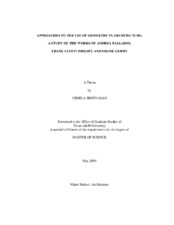| dc.description.abstract | Geometry deals with form, shape, and measurement and is a part of mathematics
where visual thought is dominant. Both design and construction in architecture deal with
visualization, and architects constantly employ geometry. Today, with the advent of
computer software, architects can visualize forms that go beyond our everyday
experience. Some architects claim that the complex forms of their works have
correlations with non-Euclidean geometry, but the space we experience is still
Euclidean. Given this context, I have explored possible correlations that might exist
between mathematical concepts of geometry and the employment of geometry in
architectural design from a historic perspective. The main focus will be to describe the
two phenomena historically, and then investigate any connections that might emerge
from the discussion. While discussing the way geometry has been approached in
architecture, I have focused on the Renaissance, Modern, and Post-modern phases as
they have a distinct style and expression. Andrea Palladio, Frank Lloyd Wright, and Frank Gehry's works will be case studies for the Renaissance, Modern, and Post-modern
phases respectively.
One of the important conclusions of this study is that architects use geometry in a
more subconscious and intuitive manner while designing. Certain approaches to
geometry can be determined by the way an architect deals with form and space. From
the discussions of the works of Palladio, Wright, and Gehry, it can be concluded that
from a two-dimensional simple approach to form and space in architecture, there has
been a development of thinking about complex forms three dimensionally. Similarly, in
mathematics, geometry has developed from a two-dimensional and abstract description
of our surroundings to something that can capture the complex and specific nature of a
phenomena. It is also shown that architects rarely come up with new concepts of
geometry. Significant developments in geometry have always been in the domain of
mathematics. Hence, most correlations between geometry in architecture and geometry
in mathematics develop much later than the introduction of those concepts of geometry
in mathematics. It is also found that the use of Euclidean geometry persists in
architecture and that later concepts like non-Euclidean geometry cannot be used in an
instrumental manner in architecture. | en |


